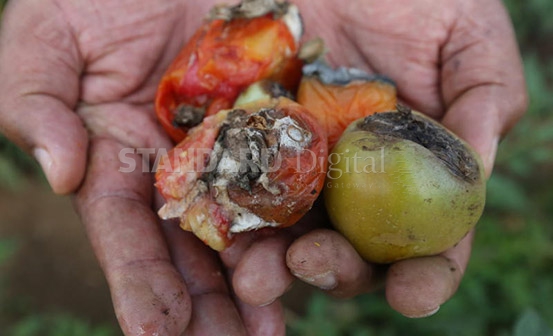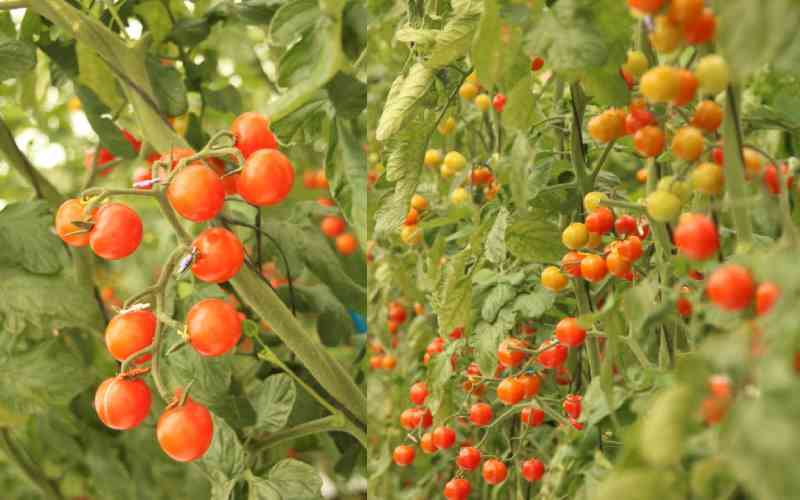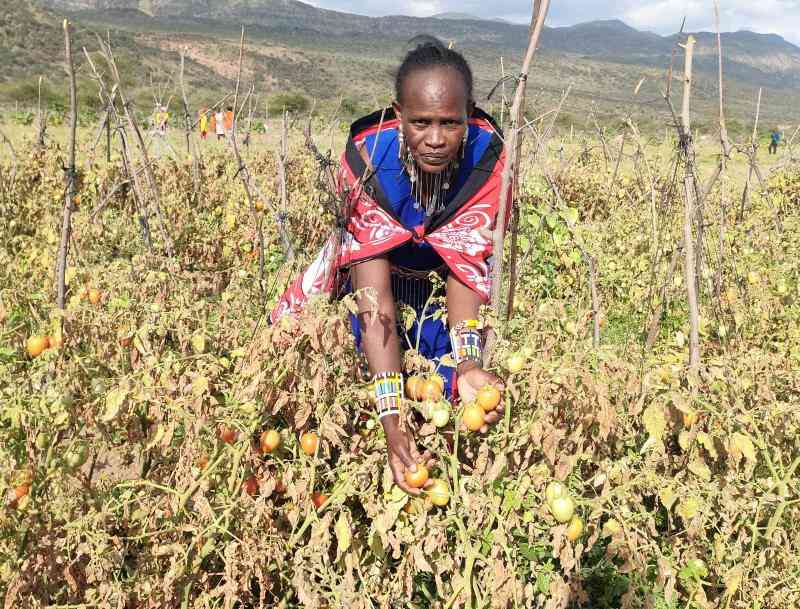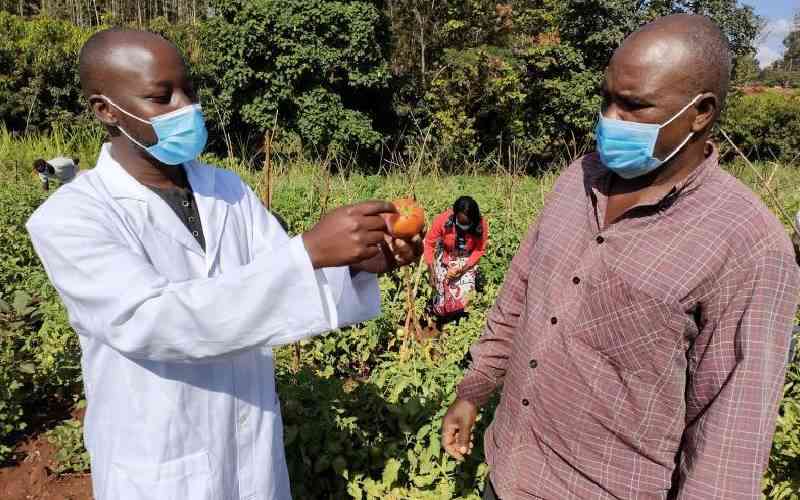
Last week, I wrote about tomato production in greenhouses and in the open fields. One of our readers was quick to point out that she has abandoned her greenhouse due to what she calls the ‘HIV of soil’. Despite successive sprays of fungicide, her tomato still succumbed to this deadly disease.
Today, I will look at this deadly but manageable soil borne disease -’the bacterial wilt’ which can cause a crop loss of up to 90 per cent.
Bacterial wilt is caused by a bacterium, which lives in the soil. A characteristic of this disease, which sets it apart from other wilt diseases, is that plants wilt and die rapidly without yellowing or spotting of the foliage. Wilting is as a result of blocked vascular tissue. To identify bacterial wilt, a farmer can cut and peel back a section of the epidermis and cortical tissue (bark) just above the soil line. In the early stages of bacterial wilt, the centre of the stem (pith) will appear water soaked; later, the centre will turn brown and sometimes become hollow. The discolouration of the pith distinguishes this disease from Fusarium and Verticillium wilt.
Another relatively easy diagnostic technique is to cut a portion of the affected stem and place it in a clear-sided glass container ?lled with water. Watch for a white, milky ooze streaming out of the cut end of the discolored vascular tissue. The white, milky ooze is diagnostic for this disease.
The first visible sign of wilt occurs on the youngest leaves, especially during the hottest part of the day. A few days later, and under conditions favourable to the disease — high temperatures and rainfall plants wilt suddenly and die. However, if the conditions are not favourable, the disease may develop slowly; in that case: the plants may be stunted; roots develop on the stem above soil level, and the lower leaves turn yellow before they wilt.
Under both favourable and unfavourable conditions, brown stains are seen in the water-conducting system of the stem when it is cut across near soil level. In eggplant, there is a slow dieback rather than a sudden wilt as occurs on tomato.
Disease management
Bacterial wilt is a difficult disease to control. There are many reasons for this: the bacteria can remain alive in the soil without a host plant for about 9 months; the bacteria can survive for several years in host debris; the bacteria have a wide host range, infecting many crops and also weeds. In addition, the bacteria can live on the roots of some plants without infecting them or causing a disease. To control the disease, ensure you test your soil for bacterial wilt before planting.
Avoid planting crops in land where bacterial wilt has occurred previously. If the drainage is poor, plant on ridges or raised beds during growth, remove wilted plants as soon as they are seen, taking as much soil from around the roots as possible, and burn the plants and soil.
Do not let infested soil fall on neighbouring healthy plants. Use containers with pasteurised soil if fields are infested with the bacterium. Remove soil from machinery, tools and shoes and wash them with water after working in bacterial wilt contaminated fields.
After harvest, practice crop rotation of at least 4 years, and during that time avoid susceptible crops and weeds in the tomato family. Note, crop rotation is only of limited use against this disease because of long survival in the soil, and wide host range. Rotations with maize, soybeans, grasses and rice have been used in rotations elsewhere.
Physical control methods such as soil solarisation combined with fumigation are other options than can reduce the pathogen considerably. Studies have indicated that solarisation using transparent plastic mulches prior to planting of tomatoes reduces the incidences of bacterial wilt. Destruction of weeds, collateral hosts and other off season hosts will reduce the innoculum potential.
A practical example is the Amiran Soil Sterilisation process where the affected soil is steamed to 80-100 degrees census hence killing the pathogen that causes the disease, farmers are able to cleanse their soils. In order to achieve this result, a farmer is supposed to use an Amiran Bacterial wilt kit that consists of; planting bags with perforations where sterilised soil is kept and later transplant seedlings onto. The perforations offer the roots ventilation to breathe. Use the Amiran Plastic Mulch to provide eco-friendly boundary between the planting bags and the affected soils.
Organic amendments to soil have direct impacts on plant health and crop productivity. They are advantageous because they improve the physical, chemical, and biological properties of soil, which can have positive effects on plant growth.
Stay informed. Subscribe to our newsletter
The growing of cultivars that are resistant to bacterial wilt is considered to be the most economical, environmentally friendly, and effective method of disease control. In Kenya, Samantha F1 and Monalisa F1 has shown resistance to this disease.
Application of sawdust, peat moss are efficient in reducing the incidence. Application of nitrite form of fertilisers is also capable of reducing the bacterial population. Calcium concentration in soil should be increased to have better control of wilt disease.
Chemical control
Although there is no known chemical cure for bacterial wilt, drenching the planting holes with copper based fungicide has shown potential to control bacterial wilt in tomatoes. Soil treatment with chloropicrin, methyl bromide or mixture of both were found effective in retarding the wilt development. Application of bleaching powder (15kg/ha) has also been found effective against this disease. Seedling dip with streptocycline avoids early invasion and infection by the pathogen through wounds formed during transplanting.
Several biological control agents such as Pseudomonas fluorescens, Bacillus licheniformis, B. cereus, B. subtilis and mycorrihiza are effective in delaying and reducing the wilt development.Other, phytosanitary measures are; limiting traffic into the greenhouse because people might carry bacteria especially on their shoes bringing them into the greenhouse, have a foot bath at the entrance of the greenhouse structure.
 The Standard Group Plc is a
multi-media organization with investments in media platforms spanning newspaper
print operations, television, radio broadcasting, digital and online services. The
Standard Group is recognized as a leading multi-media house in Kenya with a key
influence in matters of national and international interest.
The Standard Group Plc is a
multi-media organization with investments in media platforms spanning newspaper
print operations, television, radio broadcasting, digital and online services. The
Standard Group is recognized as a leading multi-media house in Kenya with a key
influence in matters of national and international interest.
 The Standard Group Plc is a
multi-media organization with investments in media platforms spanning newspaper
print operations, television, radio broadcasting, digital and online services. The
Standard Group is recognized as a leading multi-media house in Kenya with a key
influence in matters of national and international interest.
The Standard Group Plc is a
multi-media organization with investments in media platforms spanning newspaper
print operations, television, radio broadcasting, digital and online services. The
Standard Group is recognized as a leading multi-media house in Kenya with a key
influence in matters of national and international interest.










